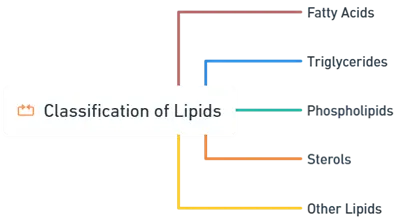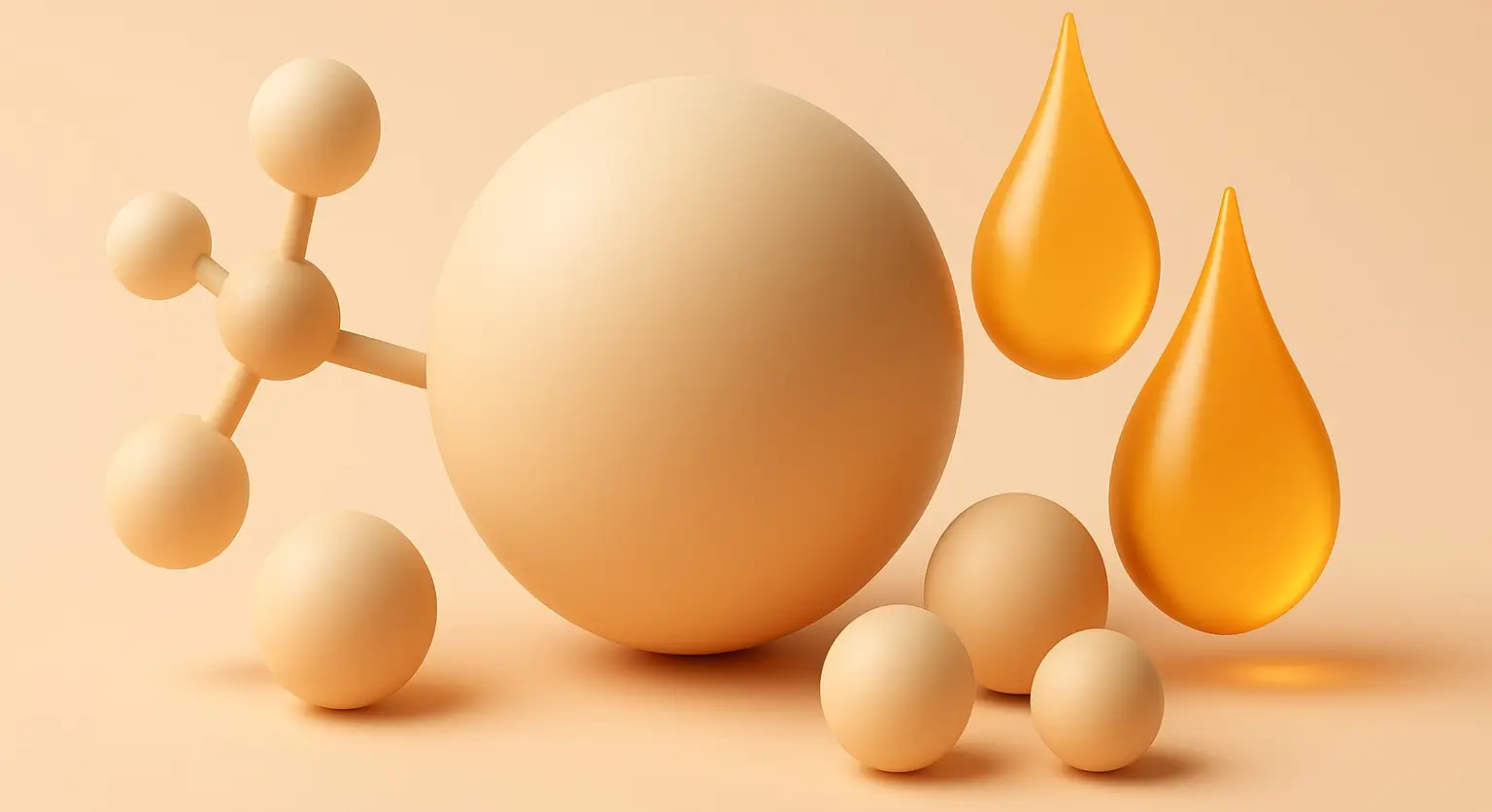- Lipids are a broad and diverse group of hydrophobic (water-insoluble) organic compounds composed mainly of carbon (C), hydrogen (H), and oxygen (O).
- Some lipid may also contain nitrogen (N) and phosphorus (P). They play essential roles in energy storage, membrane structure, signaling, and protection in living organisms.
Classification of Lipids
- Lipids are categorized based on their structure and function into the following types:

-
Fatty Acids
- Structure: Hydrocarbon chains with a terminal carboxyl (COOH) group.
- Types:
- Saturated fatty acids (single bonds only).
- Unsaturated fatty acids (one or more double bonds).
- Function: Energy source and building blocks for complex lipids.
- Examples: Palmitic acid, Oleic acid.
-
Triglycerides
- Structure: Glycerol molecule bound to three fatty acid chains.
- Function: Primary energy storage and insulation.
- Examples: Animal fats, vegetable oils.
-
Phospholipids
- Structure: Similar to triglycerides, but one fatty acid is replaced by a phosphate group.
- Function: Key components of cell membranes and signaling molecules.
- Examples: Phosphatidylcholine, Phosphatidylserine.
-
Sterols
- Structure: Four interconnected carbon rings with a hydrocarbon tail.
- Function: Membrane stability and hormone synthesis.
- Examples: Cholesterol, Ergosterol.
-
Other Lipids
- Includes: Glycolipids, sphingolipids, lipoproteins.
- Function: Involved in cell recognition, immune response, and structural functions.
Comparison Table: Lipid Types
| Classification | Structure | Function | Examples |
| Fatty Acids | Hydrocarbon chain + COOH | Energy source, building blocks | Palmitic acid, Oleic acid |
| Triglycerides | Glycerol + 3 fatty acids | Energy storage, insulation | Animal fats, Vegetable oils |
| Phospholipids | Glycerol + 2 fatty acids + Phosphate group | Cell membrane structure, signaling | Phosphatidylcholine, Phosphatidylserine |
| Sterols | Four carbon rings + hydrocarbon tail | Membrane stability, hormone synthesis | Cholesterol, Ergosterol |
| Other Lipids | Various structures | Cell recognition, immune response | Glycolipids, Sphingolipids |
Properties of Lipids
-
Hydrophobicity:
- Lipid are insoluble in water due to nonpolar hydrocarbon chains but soluble in nonpolar solvents (e.g., benzene, chloroform).
-
Melting Point:
- Saturated fatty acids have higher melting points (solid at room temp).
- Unsaturated fatty acids have lower melting points (liquid at room temp).
-
Amphiphilic Nature:
- Some lipids (e.g., phospholipids) contain both hydrophobic and hydrophilic regions, allowing them to form bilayers and micelles (crucial for cell membranes).
Functions of Lipids
-
Energy Storage:
- Triglycerides provide a high-energy source, storing more energy than carbohydrates.
-
Structural Components:
- Phospholipids and sterols maintain cell membrane integrity and fluidity.
-
Signaling Molecules:
- Steroid hormones (e.g., estrogen, testosterone) regulate growth, metabolism, and reproduction.
- Eicosanoids (derived from fatty acids) influence inflammation and immunity.
-
Insulation and Protection:
- Lipid provide thermal insulation and act as cushioning for vital organs.
- Some lipid help in waterproofing (e.g., waxes on skin and feathers).
Examples of Lipids
- Saturated Fatty Acid: Palmitic acid (found in palm oil, animal fats).
- Unsaturated Fatty Acid: Oleic acid (found in olive oil).
- Triglyceride: Triolein (stored in adipose tissue as an energy source).
- Phospholipid: Phosphatidylcholine (a major component of cell membranes).
- Sterol: Cholesterol (important for membrane structure and hormone synthesis).
Chemical Nature and Biological Role
-
Energy Storage of Lipids
- Triglycerides serve as long-term energy reserves, providing more calories per gram than carbohydrates.
-
Structural Component of Lipids:
- Phospholipids form the lipid bilayer, encapsulating cells and controlling molecular interactions.
-
Hormones and Signaling:
- Steroid hormones and lipid-derived messengers regulate metabolism, growth, and immune responses.
-
Insulation and Protection:
- Lipids insulate the body from temperature fluctuations and protect organs from physical impact.
Click Here to Watch the Best Pharma Videos

